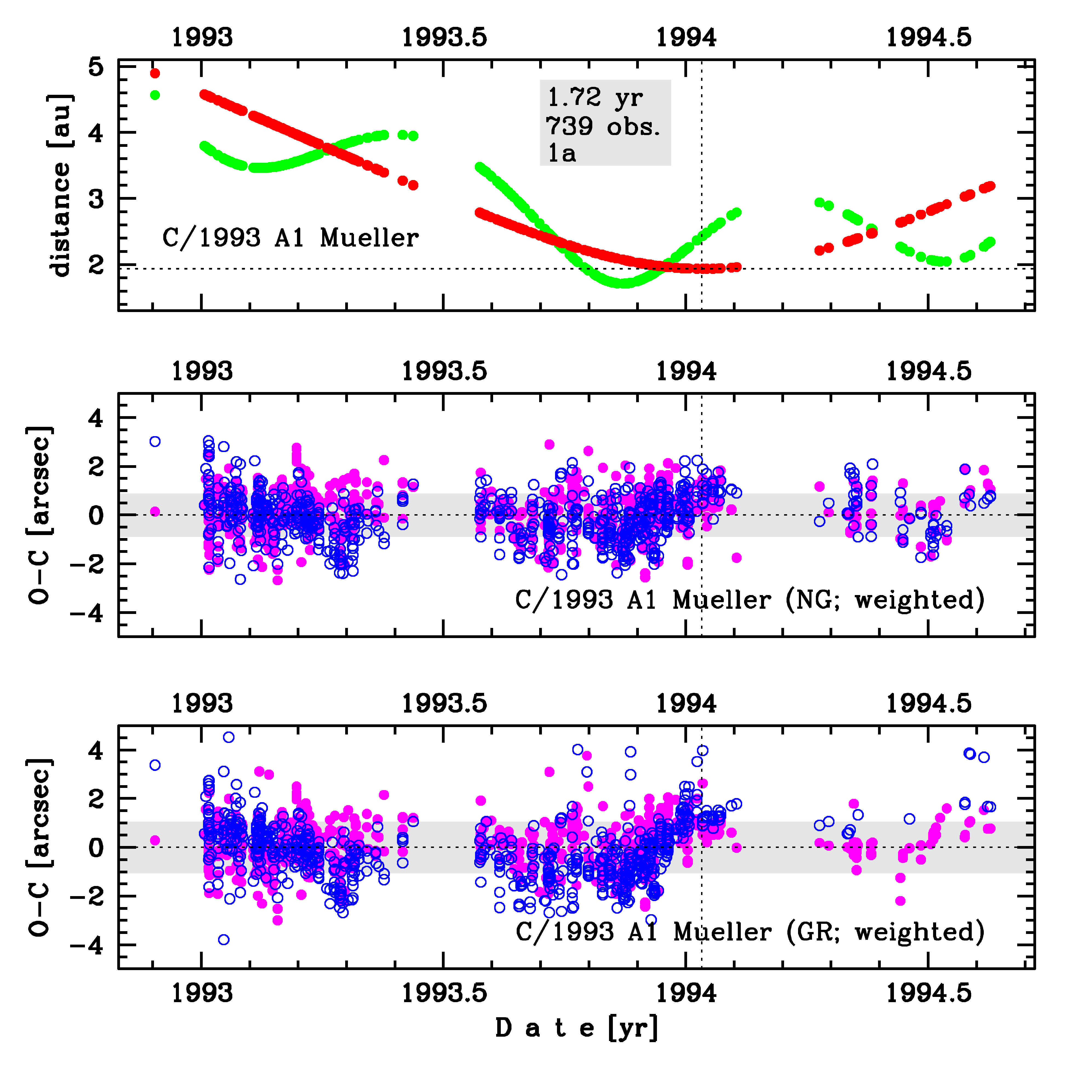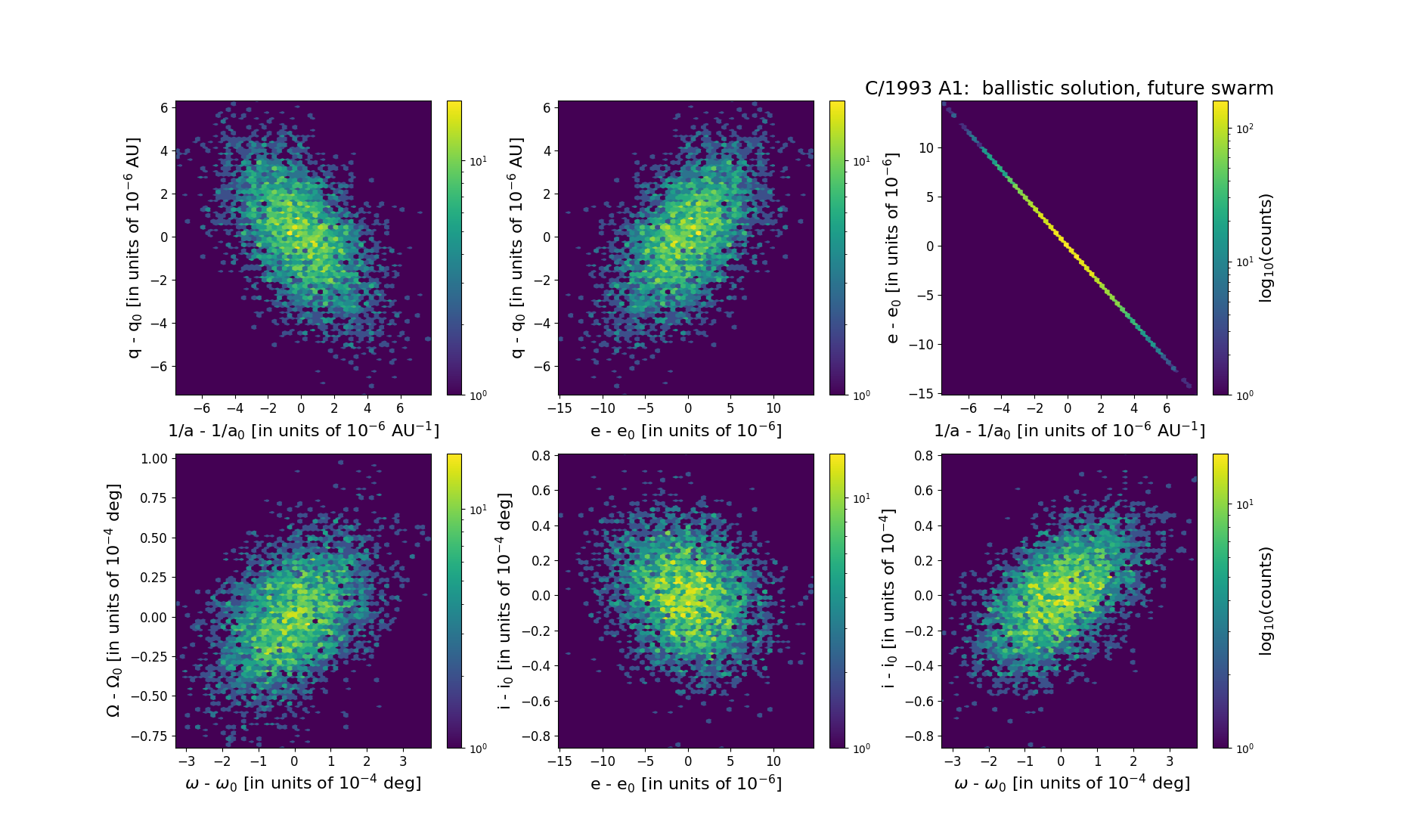C/1993 A1 Mueller
more info
Comet C/1993 A1 was discovered on 2 January 1993 by Jean Mueller (Palomar Sky Survey II). Later, a prediscovery image of this comet taken on 26 November 1992 (Catalina Station, Tucson) was found.At the moment of discovery, this comet was a year before its perihelion passage and it was last observed in the mid-August 1994.
Comet had its closest approach to the Earth on 13 November 1993 (1.713 au), 2 months before its perihelion passage.
This is a comet with nongravitational effects strongly manifested in positional data fitting.
Preferred solution given here is based on data spanning over 1.72 yr in a range of heliocentric distances: 4.89 au – 1.94 au (perihelion) – 3.19 au.
This Oort spike comet suffers moderate planetary perturbations during its passage through the planetary system; these perturbations lead to escape the comet on hyperbolic orbit from the planetary zone.See also Królikowska 2020.
Comet had its closest approach to the Earth on 13 November 1993 (1.713 au), 2 months before its perihelion passage.
This is a comet with nongravitational effects strongly manifested in positional data fitting.
Preferred solution given here is based on data spanning over 1.72 yr in a range of heliocentric distances: 4.89 au – 1.94 au (perihelion) – 3.19 au.
This Oort spike comet suffers moderate planetary perturbations during its passage through the planetary system; these perturbations lead to escape the comet on hyperbolic orbit from the planetary zone.See also Królikowska 2020.
| solution description | ||
|---|---|---|
| number of observations | 739 | |
| data interval | 1992 11 26 – 1994 08 17 | |
| data type | perihelion within the observation arc (FULL) | |
| data arc selection | entire data set (STD) | |
| range of heliocentric distances | 4.89 au – 1.94 au (perihelion) – 3.19 au | |
| detectability of NG effects in the comet's motion | comet with NG effects strongly manifested in positional data fitting | |
| type of model of motion | GR - gravitational orbit | |
| data weighting | YES | |
| number of residuals | 1442 | |
| RMS [arcseconds] | 1.06 | |
| orbit quality class | 1a | |
| orbital elements (barycentric ecliptic J2000) | ||
|---|---|---|
| Epoch | 2288 09 23 | |
| perihelion date | 1994 01 13.97020612 | ± 0.00021215 |
| perihelion distance [au] | 1.93446549 | ± 0.00000208 |
| eccentricity | 1.00089581 | ± 0.00000424 |
| argument of perihelion [°] | 130.721951 | ± 0.000107 |
| ascending node [°] | 144.875614 | ± 0.000026 |
| inclination [°] | 124.890618 | ± 0.000022 |
| reciprocal semi-major axis [10-6 au-1] | -463.08 | ± 2.19 |
| file containing 5001 VCs swarm |
|---|
| 1993a1a5.bpl |

Upper panel: Time distribution of positional observations with corresponding heliocentric (red curve) and geocentric (green curve) distance at which they were taken. The horizontal dotted line shows the perihelion distance for a given comet whereas vertical dotted line — the moment of perihelion passage.
Lower panel (panels): O-C diagram for this(two) solution (solutions) given in this database, where residuals in right ascension are shown using magenta dots and in declination by blue open circles.
Lower panel (panels): O-C diagram for this(two) solution (solutions) given in this database, where residuals in right ascension are shown using magenta dots and in declination by blue open circles.
